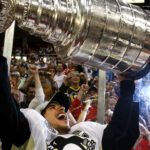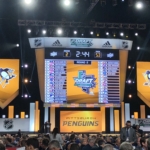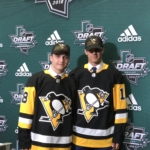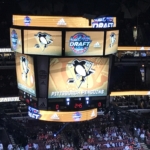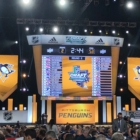By Brian Metzer
On March 22, 2012, a diverse group of journalists, bloggers, and radio personalities were handpicked by the Fan v Fan Network to participate in an exclusive conference call with CCM–Reebok general manager, Philippe Dube’.
It was a unique opportunity to question one of the brightest minds in the hockey equipment industry on everything from player safety, upcoming product offerings, research and development and those who use the equipment, the players themselves.
Dube’, who formerly worked for Taylor Made – a leader in the golf equipment industry, joined CCM-Reebok in September 2010 and worked in R&D, operations and finance before being offered his post as the company’s general manager.
The native of France was genuine, down to earth and above all, honest in the answers he provided to some tough questions. He is excited about his company’s product offerings and seemed even more excited about the advances CCM-Reebok is making in player safety.
It was especially refreshing to hear him talk off of the top of his head about all of the above including ongoing studies in the industry. Dube’ is an executive who is very in tune with his products and the game of hockey, something that isn’t always apparent with executive level employees.
The session provided a ton of great information, which we will be breaking up into several topics: Equipment Info, Player Safety, Players, and Misc.
Equipment Info
You might think that hockey equipment is just hockey equipment and that the companies just hammer out a pair of skates, some pads and some sticks and simply ship them off to market, but that isn’t the case. There is a significant amount of research, testing and actual wear that goes into preparing a product for sale.
“Helmets, that’s the longest piece of equipment because of the safety parameter and the certification,” Dube said. “Helmet development is usually three years. A skate is about two years and stick, depending on the technology could be one year or more.”
There are typically three iterations of any product before it hits the market. Thus making it almost a third generation by the time it is officially being used by National Hockey League players.
CCM-Reebok isn’t done with a product when it is launched either, they host three on ice sessions per week to test not only upcoming products but existing ones. They are also testing the competition’s equipment so that they can capture any and all feedback from the “20 to 30 individuals” who participate in each session.
Most products are initially tested in the CHL or AHL prior to being given to NHL players, which limits the risks associated with such testing.
* * * * *
One of the most intriguing facets of Philippe Dube’s involvement with CCM-Reebok is the fact that he previously worked with Taylor Made, which has created an interesting synergy between the two companies, so much so that you will soon be seeing some hockey sticks that say “powered by Taylor Made.”
“It became very evident quickly that we had a lot similarities with golf clubs and hockey sticks because we talk about stiffness, stiffness profile, torque, weight distribution, release, loading of the shaft,” Dube’ said of his reasoning for the partnership with Taylor Made. “I mean a lot of vocabulary and terms are completely identical to hockey.”
CCM-Reebok recruited a stick engineer who currently works at the Taylor Made facility in the middle of their R&D department surrounded by their composite engineers. One can only imagine the magic that is occurring there!
* * * * *
The company launched a new line of goaltending equipment on April 15, 2012 and hosted a Goalie Summit in 2011 to test the gear. Marc-Andre Fleury, J-S Giguere, Corey Crawford and Roberto Luongo were among those who participated.
“Well, the goalie, as you know, the goalie is a tribe,” Dube’ said of the enigmatic group. “That Goalie Summit…we made some video out of it and at the latest sales meeting we had I can tell you, everybody in the room had goose bumps just looking at the video.With goalies being the quirkiest of the position players, it was of particular interest to the group to see how this Summit played out.
“So very good collaboration with those guys and definitely with the pads and the people here internally developing the goalie pad.”
Summits like these provide an opportunity for the developers and the players to work hand-in-hand to make suggested changes and to work out kinks. Dube’ felt that these weeklong sessions tend to provide more data than a month of research and have proven to be “extremely, extremely” beneficial.
* * * * *
Many think it a bit odd that CCM and Reebok at times appear to be competing brands, as both are available in the market side-by-side, but that isn’t the case. There are definitely times in which they tend to focus on one end and not the other, as has been the case lately, but Dube’ assures that “we will put more emphasis into CCM equipment” moving forward.
The plan for the company is to “play the game fully with the two brands.” This means that they want to provide players multiple options with each piece of equipment, which will allow them to find something that suits them while keeping the player outfitted in CCM-Reebok gear.
* * * * *
Many folks around the league have wondered quite loudly about the possibility of “softening” up elbow and shoulder pads. Well, Mr. Dube’ has it covered and it comes in the form of the CCM Crazy Light pads that will soon be the norm in the National Hockey League.
The CCM Crazy Light pad is a product that was developed in tandem with the University of Ottawa, a relationship that we will discuss further in the Player Safety section. The pads provide the same protection that one would expect from a typical shoulder pad, but it eliminates the “offensive” aspect of the gear, in that it will no long feature a hard shell. The pad is much less aggressive to an opposing player when contact is made.
“When we had the discussion with NHL and NHLPA on this product, they were extreme impressed,” Dube’ said in praising the new gear. “Soon I would say that this type of protective will become the standard at the NHL level, because it’s providing the same level of protection without being aggressive to your opponent.”
According to Mr. Dube’ “four pounds is about 12 pucks.” So you can imagine the difference this will make in “lightening” the bigger, faster players that are so prevalent in the National Hockey League today.
The hope is that these pads will be the standard in the league starting next season. There was originally a hope to have them launch mid-season, but it was decided that it was best to wait from a logistics standpoint.
John Tavares is already a big proponent of these pads.
“J.T. was here and we gave him the Crazy Light pads, I mean right away, his reaction was ‘Wow. Gee, I can move. It’s unbelievable. I can’t believe it!’ So that was a Wow factor already with an NHL guy,” Dube’ said.
* * * * *
According to Mr. Dube’ it is much easier to get a younger player on board with new equipment and product offerings, as they are a bit more open minded. He referred to them as early adopters, while it is much more difficult to get some of the old guard to get on board with something new.
One example that was cited was that of Marty Brodeur, who is currently getting set to play in the Stanley Cup Final for the New Jersey Devils. He has been using certain pieces of equipment since his junior days. Getting a player like Brodeur is no easy task and the conversion cannot occur via mail, email or video. In these cases the company provides the player with a prototype and allows him to try out it out in his own time and during his own training sessions. Having that first hand exposure is the best salesman the company can have.
* * * * *
Another new product that was set to hit the market early in 2012 was the new Reebok 20K Skate. It features the Reepump technology that cut its teeth in Reebok athletic shoes and earlier versions of skates.
Reebok prides itself on producing a very comfortable skate and is well aware of problems such as lace bite and not enough ankle support. So they spent a great deal of time working with their R&D teams to come up with the 20K Skate.
The skate has improved durability, composite was added to reinforce support of the ankle and the bladder in the Reepump technology has successfully been used for the past six or seven years. They have also improved positioning of the eyelets to make the fit a more comfortable one.
The skate was tested by the top 300 players in Finland in the 14-15 age groups and the feedback was tremendous. All of them were impressed and talked about the improved support and great fit.
Player Safety
CCM-Reebok is focused on player safety and has done a great deal of work to research way to make equipment, including helmets, safer for all involved. They are fully aware of the concussion problems that have plagued the National Hockey League over the years and have been very proactive in working with renowned experts in the field to find solutions.
The company first wanted to get a better understanding of what a concussion actually was, so they started a safety summit in 2011, which allowed them to meet people like Dr. Charles Tator from ThinkFirst and Dr. Philip Groff from CSA, along with many other neurosurgeons and representatives from around the National Hockey League.
Though they didn’t come away with all of the answers on concussions, they were able to determine that most of them are coming from rotational impact rather than linear impact, which prompted the company to finalize a partnership with the University of Ottawa, as it is the only lab in the world working on a new testing protocol for hockey helmets. The old protocol called for only testing a helmet for linear impact.
“We’re working on the protocol and working on a new helmet concept that will reduce the rotational G-force after rotational impact,” said Dube’. “And that’s very, very critical to do and there’s no real such thing in the marketplace right now.”
A helmet that limits rotational impact will not solve all of the problems, but it is definitely a step in the right direction.
Would Reebok consider putting a “force sticker” on their helmets? Which is a device that measures force from impact and could be used to provide data on a particular hit that caused an injury? Probably not based on a number of factors, one of which was summed up nicely by Mr. Dube’ with a boxing reference.
“I think the analogy with boxing, sometime we have big boxers and they have a soft chin,” said Dube’. “That’s what they say and that’s one thing that we discussed with the neurosurgeons…the same impact, I mean one player we have no consequence; another one will have a very high concussion. So that’s why right now we are reluctant to use this kind of devices which exist.”
Force stickers are apparently only measuring linear impact and wouldn’t provide data on the rotational G-force that was mentioned above.
* * * * *
Mr. Dube’, like many hockey fans, feels that taking certain behaviors out of the game would go a long way towards protecting the league’s players. Sure, equipment is a big part of it, but holding all players to a higher standard will go a long way towards fixing the issues.
“So it’s really all actors have to get involved to improve the safety of the players, Dube’ said in regard to protecting the league’s players. “It’s not everything will come from the equipment even though we work hard on it, but we have to make the game fun and fast, but at the same time, we have to make sure that some actions are no longer allowed, because, definitely we sometimes see some bad behaviors that definitely are not helping the game and definitely are not helping the hockey population to grow, because, moms or dads could get afraid sometimes when they see what’s happening to some of the hockey players.”
* * * * *
The group was given a look behind the curtain as it was privy to some “top secret” info. CCM-Reebok is working on a new technology that would help to get the rotational G-force under control.
“We’ll, we’re working on technology that will, let’s say, will — without going into top secrets here, but there’s something that creates a boundary between the head and the outside shell of the helmet, so that one impact on one is not transferring into the other,” Dube’ said in sharing the privileged info. “So it’s some type of a buffer between the shell and the head, so that the absorption of the impact would be made.”
The Players
Being based in Pittsburgh, I was particularly curious about the relationship that CCM-Reebok has with Sidney Crosby. Crosby has carried an endorsement deal with the company since his earliest days in the league, even launching his own clothing line.
The company was very concerned about Crosby’s health over the past couple of season and was paying close attention to the situation. They were understandably thrilled to see him back on the ice and playing at a high level to finish the year out.
Did Crosby’s battle with concussion symptoms over the past couple of seasons add anything to the ongoing conversations between CCM-Reebok and the doctors and experts who are currently working on safer equipment? Does Crosby provide feedback on the equipment he uses and try to improve it? The answer to all of the above is yes.
“Sidney is probably one of the players that — I’ve met a quite a few professional players in my working life and I can tell you, Sidney’s attention to detail is unbelievable,” Dube’ gushed. “I mean the guy is extremely sensitive to every, every small detail on the product.”
Crosby, unlike the ‘stiffer the skate, the better’ sect, prefers a softer skate, which clearly doesn’t hinder his ability to blaze by defenders on a nightly basis. Dube’ chuckled as he said, “and I don’t see any loss of power when you see him skating on the ice!”
Sid the Kid brings a bit more to the R&D table than the normal player, in that he doesn’t just say “I like it” or “I don’t like it.”
“With Sidney, it’s better than that, it’s ‘I like it because’ or ‘I don’t like it because.’ So we get those feedbacks to develop products for him.”
Dube’ himself has sat down with Crosby on many occasions to get his take on all things equipment, even talking about some helmet refinements that may help in the realm of concussion prevention.
Crosby didn’t want to talk a ton about what he personally was dealing with symptom-wise, so the company respected his privacy, but he was pretty forthright about some things that could help the cause moving forward.
His SC87 brand sells best in Canada, due to a tri-party agreement with FGL, but it does move in other parts of the world, including Pittsburgh.
* * * * *
John Tavares is another favorite of Mr. Dube’, as he always provides great feedback. He was one of the first to get a chance to test out the new Crazy Light pads as mentioned above.
Dube’ also went on to praise Matt Duchene for many of the same reasons as Crosby and “J.T.” as Dube’ frequently refers to Tavares.
These three guys are actually good for us to work on development and we get some very good feedback from them,” Dube’ said while praising the talented trio of Crosby, Tavares and Duchene. “On top of that, their head is not too big and they are very down to earth and very friendly with the people and they don’t feel they are above people; they are extremely nice to deal with which is very nice.”
Alex Ovechkin was previously in the CCM-Reebok stable and he left last summer to sign with Nike-Bauer. The subject of that move provided a moment of comic relief when Mr. Dube’ was asked if the change in equipment could be responsible for Ovechkin’s statistical drop off over the past couple of seasons.
“I saw that question and I was laughing,” said Dube’. “I will let you fill the blanks definitely. But what I can say is definitely the switch to competitor’s equipment did not really improve his stats and I will let you fill in the blanks.”
Miscellaneous
Mr. Dube’ seemed to fall on the side of thinking that hockey would be a better sport if the league would look into eliminating fighting in the game. His take is one that has not yet been thrown out and it is a very interesting one. In fact, eliminating fighting from a popular European game has actually increased the physicality and made it more entertaining overall.
“In addition to being a hockey fan, I am a rugby fan and what I like to say is rugby, I think everybody would agree is somewhat a physical sport,” said Dube’. “When you see the All Blacks or some of the best teams that won the world at the speed they run and the impact and so on, and years ago, you could not have a rugby game without the fight and without the guys boxing each other, you don’t see that anymore.
“The game did not become less physical, in fact it’s the opposite; it’s much more physical than it used to be but there are no fights.”
Dube’ admitted that occasionally you still see a random fight here or there, but that it is not longer the norm. His hope is that the NHL will eventually move towards this direction where fights become an anomaly and are no longer just accepted as rule on a nightly basis.
* * * * *
Overall the experience of interviewing Mr. Dube’ was a spectacular one that yielded more information that any of us could have hoped for.
Special thanks go out to Philippe Dube’, Michael Hirschbein and everyone over at the Fan v Fan Network for setting it up.

